
- Poems Poetry Art
- Author
- Alfred French (11)
- Charles Bukowski (12)
- Clarence F Underwood (6)
- Edgar Allan Poe (16)
- Edmund Spenser (7)
- Eyvind Earle (15)
- Jack Hirschman (16)
- John Hejduk (9)
- John Milton (7)
- Lance Woolaver (7)
- Lindley Murray (8)
- Patti Smith (16)
- Reilly Rhodes (11)
- Rosaleen Norton (6)
- Shel Silverstein (9)
- Unknown (9)
- Various (40)
- William Blake (9)
- William Shakespeare (7)
- Wulf Segebrecht (17)
- ... (3209)
- Binding
- Language
- Arabic (3)
- Czech & English (11)
- Dutch (5)
- Eng, Gec (3)
- English (1340)
- English, Japanese (3)
- English, Persian (3)
- English, Russian (9)
- French (43)
- Germ, German (4)
- German (45)
- German, Germ (12)
- Hebrew (3)
- Italian (11)
- Japanese (18)
- Latin (11)
- Persian (7)
- Portuguese (3)
- Russian (19)
- Spanish (13)
- ... (1881)
- Publisher
- Abrams, Inc. (12)
- Bernard Lintott (6)
- Brill (6)
- Broadside Press (10)
- De Selliers, Diane (10)
- E. Little & Co (8)
- George Olms (16)
- Gotham Press (9)
- Hard Press (15)
- Harpercollins (7)
- J.b. Metzlersche (17)
- Museum Of Modern Art (9)
- Nimbus Publishing (7)
- Rizzoli (9)
- Samuel French (7)
- Sore Dover Press (7)
- Ten Crow Press (6)
- Thames & Hudson (6)
- Unknown (11)
- X-ray Book Company (6)
- ... (3263)
- Region
- Signed
1954 Alturas De Macchu Picchu Pablo Neruda Signed 891/1000 The Heights Of Macchu
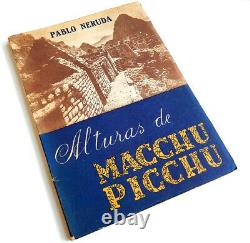
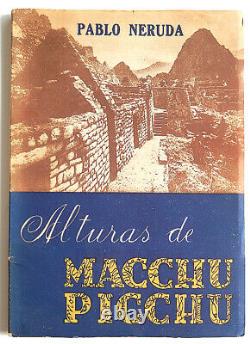
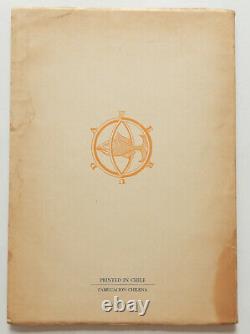

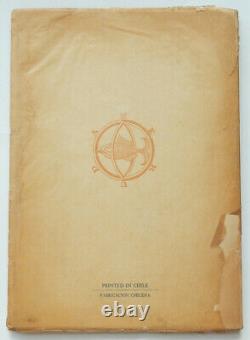

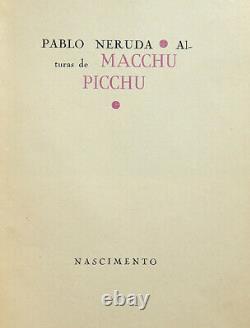

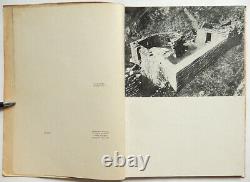
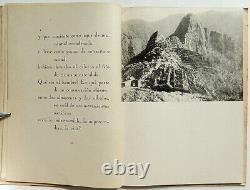
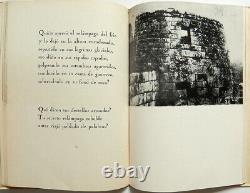
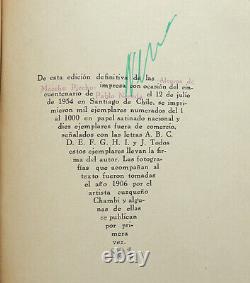


1954 ALTURAS DE MACCHU PICCHU PABLO NERUDA SIGNED 891/1000. ALTURAS DE MACCHU PICCHU ;THE HEIGHTS OF MACCHU PICCHU. Poems by PABLO NERUDA, photographs by MARTIN CHAMBI. Published in Chile in 1954 by Nascimento.
First printing of this edition. One of 1000 numbered copies, this being No. 891 and SIGNED by the Author.
Artists of both the eye and the soul here combine their genius to give us a magnificent picture of Macchu Picchu. The ancient and mysterious citadel built by the Incas has piqued human imagination since its discovery in the last century. The grandeur and mystery of the fortress resound in Pablo Neruda s poetry.
The marvels of these wondrous heights echo in the fascinating detail that you can see in Martin Chambi photographs. This book is in EXCELLENT CONDITION, contains the original paper wrapper which kept the book safe and well among the years. Back cover and the last page with some humifity stains, Front cover and pages in fresh pristine condition.
First page has handwritten dedication. Size: 10.75x7.75 inch. Please have a look at my other listings. Ricardo Eliécer Neftalí Reyes Basoalto (12 July 1904 - 23 September 1973), better known by his pen name and, later, legal name Pablo Neruda /n? /;[1] Spanish:'paßlo ne'? Uða, was a Chilean poet-diplomat and politician who won the Nobel Prize for Literature in 1971. Neruda became known as a poet when he was 13 years old, and wrote in a variety of styles, including surrealist poems, historical epics, overtly political manifestos, a prose autobiography, and passionate love poems such as the ones in his collection Twenty Love Poems and a Song of Despair (1924). Neruda occupied many diplomatic positions in various countries during his lifetime and served a term as a Senator for the Chilean Communist Party. When President Gabriel González Videla outlawed communism in Chile in 1948, a warrant was issued for Neruda's arrest. Friends hid him for months in the basement of a house in the port city of Valparaíso; Neruda escaped through a mountain pass near Maihue Lake into Argentina. Years later, Neruda was a close advisor to Chile's socialist President Salvador Allende.[3] Neruda died in his house in Isla Negra on 23 September 1973, just hours after leaving the hospital. Although it was long reported that he died of heart failure, the Interior Ministry of the Chilean government issued a statement in 2015 acknowledging a Ministry document indicating the government's official position that "it was clearly possible and highly likely" that Neruda was killed as a result of "the intervention of third parties". [4] However, an international forensic test conducted in 2013 rejected allegations that he was poisoned. It was concluded that he was suffering from prostate cancer.
[5][6] Pinochet, backed by elements of the armed forces, denied permission for Neruda's funeral to be made a public event, but thousands of grieving Chileans disobeyed the curfew and crowded the streets. Neruda is often considered the national poet of Chile, and his works have been popular and influential worldwide. The Colombian novelist Gabriel García Márquez once called him "the greatest poet of the 20th century in any language", [7] and the critic Harold Bloom included Neruda as one of the writers central to the Pablo Neruda was born Ricardo Eliécer Neftalí Reyes Basoalto on 12 July 1904, in Parral, Chile, a city in Linares Province, now part of the greater Maule Region, some 350 km south of Santiago, [8] to José del Carmen Reyes Morales, a railway employee, and Rosa Neftalí Basoalto Opazo, a schoolteacher who died two months after he was born. Soon after her death, Reyes moved to Temuco, where he married a woman, Trinidad Candia Malverde, with whom he had another child born nine years earlier, a boy named Rodolfo de la Rosa. [9] Neruda grew up in Temuco with Rodolfo and a half-sister, Laura Herminia "Laurita", from one of his father's extramarital affairs (her mother was Aurelia Tolrà, a Catalan woman).
[10] He composed his first poems in the winter of 1914. [11] Neruda was an atheist. [12] Literary career something started in my soul, fever or forgotten wings, and I made my own way, deciphering that fire and wrote the first faint line, faint without substance, pure nonsense, pure wisdom, of someone who knows nothing, and suddenly I saw the heavens unfastened and open.
From "Poetry", Memorial de Isla Negra (1964). [13] Neruda's father opposed his son's interest in writing and literature, but he received encouragement from others, including the future Nobel Prize winner Gabriela Mistral, who headed the local school. On 18 July 1917, at the age of thirteen, he published his first work, an essay titled "Entusiasmo y perseverancia" ("Enthusiasm and Perseverance") in the local daily newspaper La Mañana, and signed it Neftalí Reyes.[14] From 1918 to mid-1920, he published numerous poems, such as "Mis ojos" ("My eyes"), and essays in local magazines as Neftalí Reyes. In 1919, he participated in the literary contest Juegos Florales del Maule and won third place for his poem "Comunión ideal" or "Nocturno ideal". By mid-1920, when he adopted the pseudonym Pablo Neruda, he was a published author of poems, prose, and journalism.
He is thought to have derived his pen name from the Czech poet Jan Neruda, [15][16][17] though other sources say the true inspiration was Moravian violinist Wilma Neruda, which name appears in Arthur Conan Doyle's novel A Study in Scarlet. [18][19] The young poet's intention in publishing under a pseudonym was to avoid his father's disapproval of his poems. In 1921, at the age of 16, Neruda moved to Santiago[13] to study French at the Universidad de Chile, with the intention of becoming a teacher. However, he was soon devoting all his time to writing poems and with the help of well-known writer Eduardo Barrios, [20] he managed to meet and impress Don Carlos George Nascimento, the most important publisher in Chile at the time.In 1923, his first volume of verse, Crepusculario (Book of Twilights), was published by Editorial Nascimento, followed the next year by Veinte poemas de amor y una canción desesperada (Twenty Love Poems and A Desperate Song), [13] a collection of love poems that was controversial for its eroticism, especially considering its author's young age. Both works were critically acclaimed and have been translated into many languages.
[13] By the age of 20, Neruda had established an international reputation as a poet, but faced poverty. [13] In 1926, he published the collection Tentativa del hombre infinito (The Attempt of the Infinite Man) and the novel El habitante y su esperanza (The Inhabitant and His Hope). [21] In 1927, out of financial desperation, he took an honorary consulship in Rangoon, the capital of the British colony of Burma, then administered from New Delhi as a province of British India. Rangoon was a place he had never heard of before. [21] Later, mired in isolation and loneliness, he worked in Colombo (Ceylon), Batavia (Java), and Singapore.[22] In Batavia the following year he met and married (6 December 1930) his first wife, a Dutch bank employee named Marijke Antonieta Hagenaar Vogelzang (born as Marietje Antonia Hagenaar), [23] known as Maruca. [24] While he was in the diplomatic service, Neruda read large amounts of verse, experimented with many different poetic forms, and wrote the first two volumes of Residencia en la Tierra, which includes many surrealist poems. Diplomatic and political career Spanish Civil War After returning to Chile, Neruda was given diplomatic posts in Buenos Aires and then Barcelona, Spain.
[25] He later succeeded Gabriela Mistral as consul in Madrid, where he became the center of a lively literary circle, befriending such writers as Rafael Alberti, Federico García Lorca, and the Peruvian poet César Vallejo. [25] His only offspring, his daughter Malva Marina (Trinidad) Reyes, was born in Madrid in 1934. She was plagued with severe health problems, especially suffering from hydrocephalus. [26] She died in 1943 (nine years old), having spent most of her short life with a foster family in the Netherlands after Neruda ignored and abandoned her, forcing her mother to take what jobs she could.
[27][28][29][30] Half that time was during the Nazi occupation of Holland, when for the Nazi mentality birth defects denoted genetic inferiority at best. During this period, Neruda became estranged from his wife and instead began a relationship with Delia del Carril [es], an aristocratic Argentine artist who was twenty years his senior.
Grave of Malva Marina, sole daughter of Pablo Neruda As Spain became engulfed in civil war, Neruda became intensely politicised for the first time. His experiences during the Spanish Civil War and its aftermath moved him away from privately focused work in the direction of collective obligation.Neruda became an ardent Communist for the rest of his life. The radical leftist politics of his literary friends, as well as that of del Carril, were contributing factors, but the most important catalyst was the execution of García Lorca by forces loyal to the dictator Francisco Franco. [25] By means of his speeches and writings, Neruda threw his support behind the Spanish Republic, publishing the collection España en el corazón (Spain in Our Hearts, 1938). He lost his post as consul due to his political militancy.
[25] In July 1937 he attended the Second International Writers' Congress, the purpose of which was to discuss the attitude of intellectuals to the war in Spain, held in Valencia, Barcelona and Madrid and attended by many writers including André Malraux, Ernest Hemingway and Stephen Spender. [31] Neruda's marriage to Vogelzang broke down and Neruda eventually obtained a divorce in Mexico in 1943. His estranged wife moved to Monte Carlo to escape the hostilities in Spain and then to the Netherlands with their very ill only child, and he never saw either of them again. [32] After leaving his wife, Neruda lived with Delia del Carril in France, eventually marrying her (shortly after his divorce) in Tetecala in 1943; however his new marriage was not recognized by Chilean authorities as his divorce from Vogelzang was deemed illegal. [33] Following the election of Pedro Aguirre Cerda (whom Neruda supported) as President of Chile in 1938, Neruda was appointed special Consul for Spanish emigrants in Paris.
[34] Neruda is sometimes charged with having selected only fellow Communists for emigration, to the exclusion of others who had fought on the side of the Republic. [35] Many Republicans and Anarchists were killed during the German invasion and occupation. Others deny these accusations, pointing out that Neruda chose only a few hundred of the 2,000 refugees personally; the rest were selected by the Service for the Evacuation of Spanish Refugees set up by Juan Negrín, President of the Spanish Republican Government in Exile. Mexican appointment Neruda's next diplomatic post was as Consul General in Mexico City from 1940 to 1943. [36] While he was there, he married del Carril, and learned that his daughter Malva had died, aged eight, in the Nazi-occupied Netherlands. [37] Neruda later said that he did it at the request of the Mexican President, Manuel Ávila Camacho. This enabled Siqueiros, then jailed, to leave Mexico for Chile, where he stayed in Neruda's private residence. Neruda's relationship with Siqueiros attracted criticism, but Neruda dismissed the allegation that his intent had been to help an assassin as "sensationalist politico-literary harassment". Return to Chile In 1943, after his return to Chile, Neruda made a tour of Peru, where he visited Machu Picchu, [38] an experience that later inspired Alturas de Macchu Picchu, a book-length poem in twelve parts that he completed in 1945 and which expressed his growing awareness of, and interest in, the ancient civilizations of the Americas.He explored this theme further in Canto General (1950). In Alturas, Neruda celebrated the achievement of Machu Picchu, but also condemned the slavery that had made it possible. In Canto XII, he called upon the dead of many centuries to be born again and to speak through him. Martín Espada, poet and professor of creative writing at the University of Massachusetts Amherst, has hailed the work as a masterpiece, declaring that "there is no greater political poem".
Communism Bolstered by his experiences in the Spanish Civil War, Neruda, like many left-leaning intellectuals of his generation, came to admire the Soviet Union of Joseph Stalin, partly for the role it played in defeating Nazi Germany and partly because of an idealist interpretation of Marxist doctrine. [39] This is echoed in poems such as "Canto a Stalingrado" (1942) and "Nuevo canto de amor a Stalingrado" (1943).
In 1953, Neruda was awarded the Stalin Peace Prize. Upon Stalin's death that same year, Neruda wrote an ode to him, as he also wrote poems in praise of Fulgencio Batista, "Saludo a Batista" ("Salute to Batista"), and later to Fidel Castro. His fervent Stalinism eventually drove a wedge between Neruda and his long-time friend Octavio Paz, who commented that Neruda became more and more Stalinist, while I became less and less enchanted with Stalin. [40] Their differences came to a head after the Nazi-Soviet Ribbentrop-Molotov Pact of 1939, when they almost came to blows in an argument over Stalin.Although Paz still considered Neruda "The greatest poet of his generation", in an essay on Aleksandr Solzhenitsyn he wrote that when he thinks of Neruda and other famous Stalinist writers and poets, I feel the gooseflesh that I get from reading certain passages of the Inferno. No doubt they began in good faith... But insensibly, commitment by commitment, they saw themselves becoming entangled in a mesh of lies, falsehoods, deceits and perjuries, until they lost their souls.
[41] On 15 July 1945, at Pacaembu Stadium in São Paulo, Brazil, Neruda read to 100,000 people in honor of the Communist revolutionary leader Luís Carlos Prestes. [42] Neruda also called Vladimir Lenin the "great genius of this century", and in a speech he gave on 5 June 1946, he paid tribute to the late Soviet leader Mikhail Kalinin, who for Neruda was "man of noble life", "the great constructor of the future", and "a comrade in arms of Lenin and Stalin". [43] Neruda later came to regret his fondness for the Soviet Union, explaining that in those days, Stalin seemed to us the conqueror who had crushed Hitler's armies."[39] Of a subsequent visit to China in 1957, Neruda wrote: "What has estranged me from the Chinese revolutionary process has not been Mao Tse-tung but Mao Tse-tungism. " He dubbed this Mao Tse-Stalinism: "the repetition of a cult of a Socialist deity. "[39] Despite his disillusionment with Stalin, Neruda never lost his essential faith in Communist theory and remained loyal to "the Party.
Anxious not to give ammunition to his ideological enemies, he would later refuse publicly to condemn the Soviet repression of dissident writers like Boris Pasternak and Joseph Brodsky, an attitude with which even some of his staunchest admirers disagreed. [44] On 4 March 1945, Neruda was elected a Communist Senator for the northern provinces of Antofagasta and Tarapacá in the Atacama Desert.[45][46] He officially joined the Communist Party of Chile four months later. [36] In 1946, the Radical Party's presidential candidate, Gabriel González Videla, asked Neruda to act as his campaign manager. González Videla was supported by a coalition of left-wing parties and Neruda fervently campaigned on his behalf.
Once in office, however, González Videla turned against the Communist Party and issued the Ley de Defensa Permanente de la Democracia (Law of Permanent Defense of the Democracy). The breaking point for Senator Neruda was the violent repression of a Communist-led miners' strike in Lota in October 1947, when striking workers were herded into island military prisons and a concentration camp in the town of Pisagua. Neruda's criticism of González Videla culminated in a dramatic speech in the Chilean senate on 6 January 1948, which became known as "Yo acuso" ("I accuse"), in the course of which he read out the names of the miners and their families who were imprisoned at the concentration camp. [47] In 1959 Neruda was present as Fidel Castro was honored at a welcoming ceremony offered by the Central University of Venezuela where he spoke to a massive gathering of students and read his Canto a Bolivar.Luis Báez summarized what Neruda said: "In this painful and victorious hour that the peoples of America live, my poem with changes of place, can be understood directed to Fidel Castro, because in the struggles for freedom the fate of a Man to give confidence to the spirit of greatness in the history of our peoples". During the late 1960s, Argentine writer Jorge Luis Borges was asked for his opinion of Pablo Neruda.
Borges stated, I think of him as a very fine poet, a very fine poet. I don't admire him as a man, I think of him as a very mean man. "[48] He said that Neruda had not spoken out against Argentine President Juan Perón because he was afraid to risk his reputation, noting "I was an Argentine poet, he was a Chilean poet, he's on the side of the Communists; I'm against them. So I felt he was behaving very wisely in avoiding a meeting that would have been quite uncomfortable for both of us. [36] While in hiding, Senator Neruda was removed from office and, in September 1948, the Communist Party was banned altogether under the Ley de Defensa Permanente de la Democracia, called by critics the Ley Maldita (Accursed Law), which eliminated over 26,000 people from the electoral registers, thus stripping them of their right to vote. Neruda later moved to Valdivia, in southern Chile. From Valdivia he moved to Fundo Huishue, a forestry estate in the vicinity of Huishue Lake. Neruda's life underground ended in March 1949 when he fled over the Lilpela Pass in the Andes Mountains to Argentina on horseback. He would dramatically recount his escape from Chile in his Nobel Prize lecture.Once out of Chile, he spent the next three years in exile. [36] In Buenos Aires, Neruda took advantage of the slight resemblance between him and his friend, the future Nobel Prize-winning novelist and cultural attaché to the Guatemalan embassy Miguel Ángel Asturias, to travel to Europe using Asturias' passport. [50] Pablo Picasso arranged his entrance into Paris and Neruda made a surprise appearance there to a stunned World Congress of Peace Forces[clarification needed], while the Chilean government denied that the poet could have escaped the country. [50] Neruda spent those three years traveling extensively throughout Europe as well as taking trips to India, China, Sri Lanka and the Soviet Union.
His trip to Mexico in late 1949 was lengthened due to a serious bout of phlebitis. [51] A Chilean singer named Matilde Urrutia was hired to care for him and they began an affair that would, years later, culminate in marriage.
[51] During his exile, Urrutia would travel from country to country shadowing him and they would arrange meetings whenever they could. Matilde Urrutia was the muse for Los versos del capitán, a book of poetry which Neruda later published anonymously in 1952.From "Full Woman, Fleshly Apple, Hot Moon" Full woman, fleshly apple, hot moon, thick smell of seaweed, crushed mud and light, what obscure brilliance opens between your columns? What ancient night does a man touch with his senses? Loving is a journey with water and with stars, with smothered air and abrupt storms of flour: loving is a clash of lightning-bolts and two bodies defeated by a single drop of honey. From "Full Woman, Fleshly Apple, Hot Moon", Selected Poems translated by Stephen Mitchell (1997) [52] While in Mexico, Neruda also published his lengthy epic poem Canto General, a Whitmanesque catalog of the history, geography, and flora and fauna of South America, accompanied by Neruda's observations and experiences.
Many of them dealt with his time underground in Chile, which is when he composed much of the poem. In fact, he had carried the manuscript with him during his escape on horseback. A month later, a different edition of five thousand copies was boldly published in Chile by the outlawed Communist Party based on a manuscript Neruda had left behind.
In Mexico, he was granted honorary Mexican citizenship. [53] Neruda's 1952 stay in a villa owned by Italian historian Edwin Cerio on the island of Capri was fictionalized in Antonio Skarmeta's 1985 novel Ardiente Paciencia (Ardent Patience, later known as El cartero de Neruda, or Neruda's Postman), which inspired the popular film Il Postino (1994). [54] Second return to Chile Neruda recording his poetry at the U. Library of Congress in 1966 By 1952, the González Videla government was on its last legs, weakened by corruption scandals. The Chilean Socialist Party was in the process of nominating Salvador Allende as its candidate for the September 1952 presidential elections and was keen to have the presence of Neruda, by now Chile's most prominent left-wing literary figure, to support the campaign.Del Carril eventually learned of his affair with Matilde Urrutia and he sent her back to Chile in 1955. She convinced the Chilean officials to lift his arrest, allowing Urrutia and Neruda to go to Capri, Italy. Now united with Urrutia, Neruda would, aside from many foreign trips and a stint as Allende's ambassador to France from 1970 to 1973, spend the rest of his life in Chile.
By this time, Neruda enjoyed worldwide fame as a poet, and his books were being translated into virtually all the major languages of the world. [36] He vigorously denounced the United States during the Cuban Missile Crisis and later in the decade he likewise repeatedly condemned the U. For its involvement in the Vietnam War. But being one of the most prestigious and outspoken left-wing intellectuals alive, he also attracted opposition from ideological opponents.
The Congress for Cultural Freedom, an anti-communist organization covertly established and funded by the U. Central Intelligence Agency, adopted Neruda as one of its primary targets and launched a campaign to undermine his reputation, reviving the old claim that he had been an accomplice in the attack on Leon Trotsky in Mexico City in 1940. [55] The campaign became more intense when it became known that Neruda was a candidate for the 1964 Nobel Prize, which was eventually awarded to Jean-Paul Sartre[56] (who rejected it). La Sebastiana, Neruda's house in Valparaíso In 1966, Neruda was invited to attend an International PEN conference in New York City. [57] Officially, he was barred from entering the U.
[57] Neruda gave readings to packed halls, and even recorded some poems for the Library of Congress. [57] Miller later opined that Neruda's adherence to his communist ideals of the 1930s was a result of his protracted exclusion from "bourgeois society". Due to the presence of many Eastern Bloc writers, Mexican writer Carlos Fuentes later wrote that the PEN conference marked a "beginning of the end" of the Cold War. [57] Upon Neruda's return to Chile, he stopped in Peru, where he gave readings to enthusiastic crowds in Lima and Arequipa and was received by President Fernando Belaúnde Terry.
[57] However, this visit also prompted an unpleasant backlash; because the Peruvian government had come out against the government of Fidel Castro in Cuba, July 1966 saw more than one hundred Cuban intellectuals retaliate against the poet by signing a letter that charged Neruda with colluding with the enemy, calling him an example of the "tepid, pro-Yankee revisionism" then prevalent in Latin America. The affair was particularly painful for Neruda because of his previous outspoken support for the Cuban revolution, and he never visited the island again, even after receiving an invitation in 1968. After the death of Che Guevara in Bolivia in 1967, Neruda wrote several articles regretting the loss of a "great hero".[58] At the same time, he told his friend Aida Figueroa not to cry for Che, but for Luis Emilio Recabarren, the father of the Chilean communist movement, who preached a pacifist revolution over Che's violent ways. Last years and death La Chascona, Neruda's house in Santiago In 1970, Neruda was nominated as a candidate for the Chilean presidency, but ended up giving his support to Salvador Allende, who later won the election and was inaugurated in 1970 as Chile's first democratically elected socialist head of state.
[53][59] Shortly thereafter, Allende appointed Neruda the Chilean ambassador to France, lasting from 1970 to 1972; his final diplomatic posting. During his stint in Paris, Neruda helped to renegotiate the external debt of Chile, billions owed to European and American banks, but within months of his arrival in Paris his health began to deteriorate.
Buenos Aires 1971 In 1971, Neruda was awarded the Nobel Prize, [53] a decision that did not come easily because some of the committee members had not forgotten Neruda's past praise of Stalinist dictatorship. But his Swedish translator, Artur Lundkvist, did his best to ensure the Chilean received the prize. [60] "A poet, " Neruda stated in his Stockholm speech of acceptance of the Nobel Prize, is at the same time a force for solidarity and for solitude. [61] The following year Neruda was awarded the prestigious Golden Wreath Award at the Struga Poetry Evenings. [62] As the coup d'état of 1973 unfolded, Neruda was diagnosed with prostate cancer.
The military coup led by General Augusto Pinochet saw Neruda's hopes for Chile destroyed. Shortly thereafter, during a search of the house and grounds at Isla Negra by Chilean armed forces at which Neruda was reportedly present, the poet famously remarked: Look around - there's only one thing of danger for you here - poetry. "[63] Neruda laid out in his coffin, 1973 It was originally reported that, on the evening of 23 September 1973, at Santiago's Santa María Clinic, Neruda had died of heart failure;[64][65][66] However, "(t)hat day, he was alone in the hospital where he had already spent five days. His health was declining and he called his wife, Matilde Urrutia, so she could come immediately because they were giving him something and he wasn't feeling good. [4] On 12 May 2011, the Mexican magazine Proceso published an interview with his former driver Manuel Araya Osorio in which he states that he was present when Neruda called his wife and warned that he believed Pinochet had ordered a doctor to kill him, and that he had just been given an injection in his stomach. [3] He would die six and a half hours later. Even reports from the pro-Pinochet El Mercurio newspaper[citation needed] the day after Neruda's death refer to an injection given immediately before Neruda's death. According to an official Chilean Interior Ministry report[citation needed] prepared in March 2015 for the court investigation into Neruda's death, "he was either given an injection or something orally" at the Santa María Clinic which caused his death six-and-a-half hours later. The 1971 Nobel laureate was scheduled to fly to Mexico where he may have been planning to lead a government in exile that would denounce General Augusto Pinochet, who led the coup against Allende on September 11, according to his friends, researchers and other political observers. [4] The funeral took place amidst a massive police presence, and mourners took advantage of the occasion to protest against the new regime, established just a couple of weeks before. Neruda's house was broken into and his papers and books taken or destroyed. [53] In 1974, his Memoirs appeared under the title I Confess I Have Lived, updated to the last days of the poet's life, and including a final segment describing the death of Salvador Allende during the storming of the Moneda Palace by General Pinochet and other generals - occurring only twelve days before Neruda died.[53] Matilde Urrutia subsequently compiled and edited for publication the memoirs and possibly his final poem "Right Comrade, It's the Hour of the Garden". These and other activities brought her into conflict with Pinochet's government, which continually sought to curtail Neruda's influence on the Chilean collective consciousness[citation needed]. Urrutia's own memoir, My Life with Pablo Neruda, was published posthumously in 1986. [67] Manuel Araya, his Communist Party-appointed chauffeur, published a book about Neruda's final days in 2012. [68] Controversy Rumored murder and exhumation In June 2013, a Chilean judge ordered that an investigation be launched, following suggestions that Neruda had been killed by the Pinochet regime for his pro-Allende stance and political views.
Neruda's driver, Manuel Araya, stated that doctors had administered poison as the poet was preparing to go into exile. [69][70] In December 2011, Chile's Communist Party asked Chilean Judge Mario Carroza to order the exhumation of the remains of the poet. Carroza had been conducting probes into hundreds of deaths allegedly connected to abuses of Pinochet's regime from 1973 to 1990.
[68][71] Carroza's inquiry during 2011-12 uncovered enough evidence to order the exhumation in April 2013. [72] Eduardo Contreras, a Chilean lawyer who was leading the push for a full investigation, commented: We have world-class labs from India, Switzerland, Germany, the US, Sweden, they have all offered to do the lab work for free.The Pablo Neruda Foundation fought the exhumation under the grounds that the Araya's claims were unbelievable. [70] In June 2013 a court order was issued to find the man who allegedly poisoned Neruda. Police were investigating Michael Townley, who was facing trial for the killings of General Carlos Prats (Buenos Aires, 1974), and ex Chancellor Orlando Letelier (Washington, 1976).
[73][74] The Chilean government suggested that the 2015 test showed it was "highly probable that a third party" was responsible for his death. [75] Test results were released on 8 November 2013 of the seven-month investigation by a 15-member forensic team. Patricio Bustos, the head of Chile's medical legal service, stated No relevant chemical substances have been found that could be linked to Mr. Neruda's death at the time.
[76] However, Carroza said that he was waiting for the results of the last scientific tests conducted in May (2015), which found that Neruda was infected with the Staphylococcus aureus bacterium, which can be highly toxic and result in death if modified. Machu Picchu is a 15th-century Inca citadel, located in the Eastern Cordillera of southern Peru, on a 2,430-metre (7,970 ft) mountain ridge.
[2][3] It is located in the Machupicchu District within Urubamba Province[4] above the Sacred Valley, which is 80 kilometres (50 mi) northwest of Cuzco. The Urubamba River flows past it, cutting through the Cordillera and creating a canyon with a tropical mountain climate. [5] For most speakers of English or Spanish, the first'c' in Picchu is silent. In English, the name is pronounced /?/[6][7] or /? /, [7][8] in Spanish as'mat? U, [9] and in Quechua (Machu Pikchu)[10] as'mat?? Often mistakenly referred to as the "Lost City of the Incas", it is the most familiar icon of Inca civilization.
The Incas built the estate around 1450 but abandoned it a century later at the time of the Spanish conquest. Although known locally, it was not known to the Spanish during the colonial period and remained unknown to the outside world until American historian Hiram Bingham brought it to international attention in 1911. Machu Picchu was built in the classical Inca style, with polished dry-stone walls. Its three primary structures are the Intihuatana, the Temple of the Sun, and the Room of the Three Windows. Most of the outlying buildings have been reconstructed in order to give tourists a better idea of how they originally appeared.
[11] By 1976, 30% of Machu Picchu had been restored[11] and restoration continues. [12] Machu Picchu was declared a Peruvian Historic Sanctuary in 1981 and a UNESCO World Heritage Site in 1983. [13] In 2007, Machu Picchu was voted one of the New Seven Wonders of the World in a worldwide internet poll.[14] Contents 1 Etymology 2 History Etymology In the Quechua language, machu means "old" or "old person", while pikchu means either "portion of coca being chewed" or "pyramid, pointed multi-sided solid; cone". [15] Thus the name of the site is sometimes interpreted as "old mountain". Svg This section relies too much on references to primary sources. Please improve this section by adding secondary or tertiary sources.
(July 2020) (Learn how and when to remove this template message) Photograph of Machu Picchu taken by Hiram Bingham III in 1912 after major clearing and before reconstruction work began. [17][12] Machu Picchu is believed by Richard L. Burger to have been built in the 1450s. [19][20]:xxxvi There is a consensus among archaeologists that Pachacutec ordered the construction of the royal estate for himself, most likely after a successful military campaign. Though Machu Picchu is considered to be a "royal" estate, surprisingly, it would not have been passed down in the line of succession. Rather it was used for 80 years before being abandoned, seemingly because of the Spanish Conquests in other parts of the Inca Empire. [18][page needed] It is possible that most of its inhabitants died from smallpox introduced by travelers before the Spanish conquistadors arrived in the area. [21] Daily life in Machu Picchu During its use as a royal estate, it is estimated that about 750 people lived there, with most serving as support staff (yanaconas, yana)[18][page needed][22] who lived there permanently. Though the estate belonged to Pachacutec, religious specialists and temporary specialized workers (mayocs) lived there as well, most likely for the ruler's well-being and enjoyment. During the harsher season, staff dropped down to around a hundred servants and a few religious specialists focused on maintenance alone. [18][page needed] Studies show that according to their skeletal remains, most people who lived there were immigrants from diverse backgrounds. They lacked the chemical markers and osteological markers they would have if they had been living there their whole lives. Instead, there was bone damage from various species of water parasites indigenous to different areas of Peru. There were also varying osteological stressors and varying chemical densities suggesting varying long-term diets characteristic of specific regions that were spaced apart.[23] These diets are composed of varying levels of maize, potatoes, grains, legumes, and fish, but the overall most recent short-term diet for these people was composed of less fish and more corn. This suggests that several of the immigrants were from more coastal areas and moved to Machu Picchu where corn was a larger portion of food intake. [22] Most skeletal remains found at the site had lower levels of arthritis and bone fractures than those found in most sites of the Inca Empire.
Inca individuals who had arthritis and bone fractures were typically those who performed heavy physical labor (such as the Mit'a) or served in the Inca military. [18][page needed] Llama with Machu Picchu ruins in the background Animals are also suspected to have migrated to Machu Picchu as there were several bones found that were not native to the area. Most animal bones found were from llamas and alpacas.These animals naturally live at altitudes of 4,000 metres (13,000 ft) rather than the 2,400 metres (7,900 ft) elevation of Machu Picchu. Most likely, these animals were brought in from the Puna region[24] for meat consumption and for their pelts. Guinea pigs were also found at the site in special burial caves, suggesting that they were at least used for funerary rituals, [18][page needed] as it was common throughout the Inca Empire to use them for sacrifices and meat. [25] Six dogs were also recovered from the site. Due to their placements among the human remains, it is believed that they served as companions of the dead.
[18][page needed] Agriculture Terraces used for farming at Machu Picchu Much of the farming done at Machu Picchu was done on its hundreds of man-made terraces. These terraces were a work of considerable engineering, built to ensure good drainage and soil fertility while also protecting the mountain itself from erosion and landslides. However, the terraces were not perfect, as studies of the land show that there were landslides that happened during the construction of Machu Picchu.
Still visible are places where the terraces were shifted by landslides and then stabilized by the Inca as they continued to build around the area. [26] It is estimated that the area around the site has received more than 1,800 mm (71 in) of rain per year since AD 1450, which was more than needed to support crop growth there. Because of the large amount of rainfall at Machu Picchu, it was found that irrigation was not needed for the terraces. The terraces received so much rain that they were built by Incan engineers specifically to allow for ample drainage of the extra water. Excavation and soil analyses done by Kenneth Wright [27][28][29] in the 1990s showed that the terraces were built in layers, with a bottom layer of larger stones covered by loose gravel.
[26] On top of the gravel was a layer of mixed sand and gravel packed together, with rich topsoil covering all of that. It was shown that the topsoil was probably moved from the valley floor to the terraces because it was much better than the soil higher up the mountain. [18][page needed] However, it has been found that the terrace farming area makes up only about 4.9 ha (12 acres) of land, and a study of the soil around the terraces showed that what was grown there was mostly corn and potatoes, which was not enough to support the 750+ people living at Machu Picchu.
This explains why when studies were done on the food that the Inca ate at Machu Picchu, it was found that most of what they ate was imported from the surrounding valleys and farther afield. [23] Encounters Even though Machu Picchu was located only about 80 kilometers (50 mi) from the Inca capital in Cusco, the Spanish never found it and so did not plunder or destroy it, as they did many other sites.
[30][20]:xxx The conquistadors had notes of a place called Piccho, although no record of a Spanish visit exists. Unlike other locations, sacred rocks often defaced by the conquistadors remain untouched at Machu Picchu. [31] Over the centuries, the surrounding jungle overgrew the site, and few outside the immediate area knew of its existence. The site may have been discovered and plundered in 1867 by a German businessman, Augusto Berns. [32] Some evidence indicates that the German engineer J.
Maps show references to Machu Picchu as early as 1874. [33] In 1911 American historian and explorer Hiram Bingham traveled the region looking for the old Inca capital and was led to Machu Picchu by a villager, Melchor Arteaga. Bingham found the name Agustín Lizárraga and the date 1902 written in charcoal on one of the walls.
Though Bingham was not the first to visit the ruins, he was considered the scientific discoverer who brought Machu Picchu to international attention. Bingham organized another expedition in 1912 to undertake major clearing and excavation. [20]:xxx-xxxi[non-primary source needed] In 1981, Peru declared an area of 325.92 square kilometres (125.84 sq mi) surrounding Machu Picchu a "historic sanctuary".
In addition to the ruins, the sanctuary includes a large portion of the adjoining region, rich with the flora and fauna of the Peruvian Yungas and Central Andean wet puna ecoregions. [34] In 1983, UNESCO designated Machu Picchu a World Heritage site, describing it as "an absolute masterpiece of architecture and a unique testimony to the Inca civilization". [35] First American expedition Melchor Arteaga crossing the Urubamba River on 24 July 1911 Sergeant Carrasco at Machu Picchu on 24 July 1911 Bingham was a lecturer at Yale University, although not a trained archaeologist. In 1909, returning from the Pan-American Scientific Congress in Santiago, he travelled through Peru and was invited to explore the Inca ruins at Choqquequirau in the Apurímac Valley. He organized the 1911 Yale Peruvian Expedition in part to search for the Inca capital, which was thought to be the city of Vitcos.He consulted Carlos Romero, one of the chief historians in Lima who showed him helpful references and Father Antonio de la Calancha's Chronicle of the Augustinians. In particular, Ramos thought Vitcos was near a great white rock over a spring of fresh water. Back in Cusco again, Bingham asked planters about the places mentioned by Calancha, particularly along the Urubamba River. According to Bingham, "one old prospector said there were interesting ruins at Machu Picchu, " though his statements were given no importance by the leading citizens.
Only later did Bingham learn that Charles Wiener also heard of the ruins at Huayna Picchu and Machu Picchu, but was unable to reach them. [20][non-primary source needed] Hiram Bingham III at his tent door near Machu Picchu in 1912 Armed with this information the expedition went down the Urubamba River.En route, Bingham asked local people to show them Inca ruins, especially any place described as having a white rock over a spring. [20]:137[non-primary source needed] At Mandor Pampa, Bingham asked farmer and innkeeper Melchor Arteaga if he knew of any nearby ruins. Arteaga said he knew of excellent ruins on the top of Huayna Picchu.
[36] The next day, 24 July, Arteaga led Bingham and Sergeant Carrasco across the river on a log bridge and up the Machu Picchu site. At the top of the mountain, they came across a small hut occupied by a couple of Quechua, Richard and Alvarez, who were farming some of the original Machu Picchu agricultural terraces that they had cleared four years earlier. Alvarez's 11-year-old son, Pablito, led Bingham along the ridge to the main ruins.
[31] The ruins were mostly covered with vegetation except for the cleared agricultural terraces and clearings used by the farmers as vegetable gardens. Because of the vegetation, Bingham was not able to observe the full extent of the site. He took preliminary notes, measurements, and photographs, noting the fine quality of Inca stonework of several principal buildings. Bingham was unclear about the original purpose of the ruins, but decided that there was no indication that it matched the description of Vitcos. [20]:141, 186-187[non-primary source needed] The expedition continued down the Urubamba and up the Vilcabamba Rivers examining all the ruins they could find. Guided by locals, Bingham rediscovered and correctly identified the site of the old Inca capital, Vitcos (then called Rosaspata), and the nearby temple of Chuquipalta.He then crossed a pass and into the Pampaconas Valley where he found more ruins heavily buried in the jungle undergrowth at Espíritu Pampa, which he named "Trombone Pampa". [37] As was the case with Machu Picchu, the site was so heavily overgrown that Bingham could only note a few of the buildings. In 1964, Gene Savoy further explored the ruins at Espiritu Pampa and revealed the full extent of the site, identifying it as Vilcabamba Viejo, where the Incas fled after the Spanish drove them from Vitcos.
The expedition undertook a four-month clearing of the site with local labour, which was expedited with the support of the Prefect of Cuzco. Excavation started in 1912 with further excavation undertaken in 1914 and 1915. Bingham focused on Machu Picchu because of its fine Inca stonework and well-preserved nature, which had lain undisturbed since the site was abandoned. None of Bingham's several hypotheses explaining the site held up. During his studies, he carried various artifacts back to Yale.One prominent artifact was a set of 15th-century, ceremonial Incan knives made from bismuth bronze; they are the earliest known artifact containing this alloy. [39][40] Although local institutions initially welcomed the exploration, they soon accused Bingham of legal and cultural malpractice.
[41] Rumors arose that the team was stealing artifacts and smuggling them out of Peru through Bolivia. In fact, Bingham removed many artifacts, but openly and legally; they were deposited in the Yale University Museum. Bingham was abiding by the 1852 Civil Code of Peru; the code stated that archaeological finds generally belonged to the discoverer, except when they had been discovered on private land. (Batievsky 100)[42] Local press perpetuated the accusations, claiming that the excavation harmed the site and deprived local archaeologists of knowledge about their own history. [41] Landowners began to demand rent from the excavators.
[41] By the time Bingham and his team left Machu Picchu, locals had formed coalitions to defend their ownership of Machu Picchu and its cultural remains, while Bingham claimed the artifacts ought to be studied by experts in American institutions. [41] Human sacrifice and mysticism Little information describes human sacrifices at Machu Picchu, though many sacrifices were never given a proper burial, and their skeletal remains succumbed to the elements. [43] However, there is evidence that retainers were sacrificed to accompany a deceased noble in the afterlife. [43]:107, 119 Animal, liquid and dirt sacrifices to the gods were more common, made at the Altar of the Condor.The tradition is upheld by members of the New Age Andean religion. [44]:263 Geography Map of Machu Picchu Machu Picchu lies in the southern hemisphere, 13.164 degrees south of the equator.
[45] It is 80 kilometres (50 miles) northwest of Cusco, on the crest of the mountain Machu Picchu, located about 2,430 metres (7,970 feet) above mean sea level, over 1,000 metres (3,300 ft) lower than Cusco, which has an elevation of 3,400 metres (11,200 ft). [45] As such, it had a milder climate than the Inca capital. It is one of the most important archaeological sites in South America, one of the most visited tourist attractions in Latin America[46] and the most visited in Peru. Machu Picchu features wet humid summers and dry frosty winters, with the majority of the annual rain falling from October through to March. [45] Machu Picchu is situated above a bow of the Urubamba River, which surrounds the site on three sides, where cliffs drop vertically for 450 metres (1,480 ft) to the river at their base.The area is subject to morning mists rising from the river. [30] The location of the city was a military secret, and its deep precipices and steep mountains provided natural defenses.
The Inca Bridge, an Inca grass rope bridge, across the Urubamba River in the Pongo de Mainique, provided a secret entrance for the Inca army. Another Inca bridge was built to the west of Machu Picchu, the tree-trunk bridge, at a location where a gap occurs in the cliff that measures 6 metres (20 ft). The city sits in a saddle between the two mountains Machu Picchu and Huayna Picchu, [30] with a commanding view down two valleys and a nearly impassable mountain at its back. It has a water supply from springs that cannot be blocked easily. The hillsides leading to it were terraced, to provide more farmland to grow crops and to steepen the slopes that invaders would have to ascend.The terraces reduced soil erosion and protected against landslides. [47] Two high-altitude routes from Machu Picchu cross the mountains back to Cusco, one through the Sun Gate, and the other across the Inca bridge. Both could be blocked easily, should invaders approach along them.
This item is in the category "Books & Magazines\Antiquarian & Collectible". The seller is "levant-fair" and is located in this country: IL. This item can be shipped worldwide.
- Year Printed: 1954
- Country/Region of Manufacture: Chile
- Topic: Poetry
- Binding: Softcover, Wraps
- Region: South America
- Author: PABLO NERUDA
- Subject: Art & Photography
- Original/Facsimile: Original
- Language: Spanish
- Place of Publication: Chile
- Special Attributes: Signed, 1st Edition, Illustrated, Limited Edition

